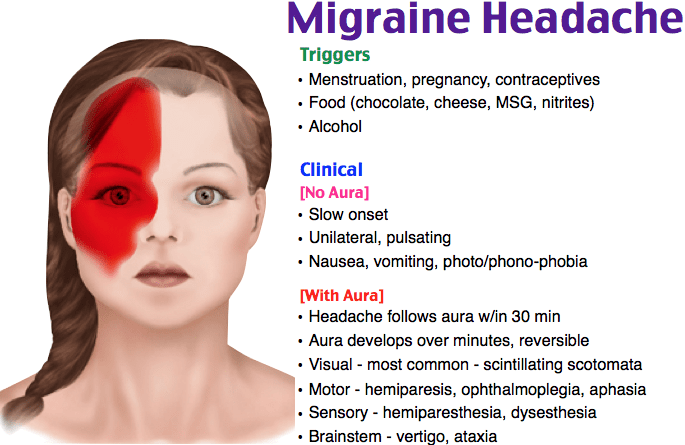Migraine is a neurological condition characterized by severe and recurrent headaches, along with pulsating sensation. It usually affects one side of the head and accompanied by extreme photosensitivity, vomiting, and nausea. Before the attack, sensory changes occur in the body called “Aura.” Aura includes blind spots and flashes in the eyes, difficulty in speaking, and tingling sensation on one side of the face or limbs. Migraine attacks are different from headaches and can be intense enough that it interferes with your daily routine. Attacks usually range from a few hours to days. Migraine severity and nature among people may vary in severity, symptoms, number of episodes, and frequency. According to statistical data compiled in 2015, it was found that migraine affects approximately 9% males and 19% of females. Migraine attacks are more common in adults between 18 to 44 years, but they can happen at any time, as well as in childhood.
.jpg)
Signs and Symptoms:
Migraine usually has four stages. These stages do not occur in everyone who is suffering from migraines but in a high proportion of migraine patients. Stages include:
Prodrome:
One or two days prior to a migraine attack, a person may observe negligible changes that notify an approaching migraine, such as food cravings, increased thirst, constipation, neck stiffness, mood changes (ranging from depression to exhilaration), increase urinary frequency, and frequent yawning.
Aura:
In some patients, the aura may occur earlier or during migraines. Auras are due to disturbance in the sensory nervous system. Each symptom usually starts slowly, builds up over various minutes, and persists for 20 minutes to one hour. Aura symptoms include:
- Visual phenomena, like seeing dark or bright spots and various shades
- Vision disturbance
- Needles and pins sensations in limbs
- Numbness and weakness in the single side of the body or face
- Difficulty in speaking
- Hearing music and noises
- Overpowering jerks and other involuntary movements
Attack
Untreated migraine generally lasts between four hours to 3 days. The severity of attacks varies among different people. Symptoms of a migraine attack include:
- Vomiting and nausea
- Usually One-sided head pain, but may occur on both sides
- Sensitivity to sound, smell, light, and touch
- Pulsing or throbbing pain
Post-drome
After a migraine attack, a person might feel confused, washed out, drained, and elated for some hours to the whole day. The sudden head movement may cause pain, briefly.

Causes:
Genetics and environmental factors are the chief components in the causation of migraines. Changes in the parts of the brain, especially medulla, pons, and midbrain and interaction with the trigeminal nerve, can cause migraines. Imbalances in neurotransmitters, like serotonin and calcitonin gene-related peptide (CGRP) present in the brain, is also a cause of migraine.
Migraine triggers:
Migraine triggers include:
- Hormonal changes, especially estrogen in females
- Sensory stimuli like glare, bright lights, loud sounds, and secondhand smoke
- Medications that interfere with hormones in the body, such as hormone replacement therapy and oral contraceptives
- Drugs, especially vasodilators, such as nitroglycerin
- Food additives, including sweetener aspartame and monosodium glutamate (MSG)
- Increased alcohol and caffeine intake
- Food items such as salty items, processed foods, aged cheeses
- Excessive stress or tense situations
- Sleep disturbances such as missing sleep, jet lag, and excessive sleep
- Physical stimuli such as increase sexual activity or intense physical exercise
- A change of barometric pressure or weather
- Skipping meals, Irregular intake of meals, and fasting
Diagnosis:
Neurologists usually diagnose migraines on the basis of symptoms, family history, patient’s medical history, and complete neurological and physical examination. For complicated or more severe cases, the following investigations are available:
Magnetic resonance imaging (MRI)
Detailed images of the brain and blood vessels can be obtained with the help of powerful radio waves and magnetic fields used in MRI procedures. MRI scans can help radiologists and other doctors to diagnose strokes, bleeding, tumors, infections, and other neurological disorders.
CT scan
A CT scan uses X-rays to display detailed cross-sectional pictures of the brain. This can help physicians in the diagnosis of infections, tumors, bleeding in the brain, brain injury, and other various medical disorders that can cause headaches.
Treatment:
Migraine treatment helps to reduce the severity of symptoms and prevent recurrent attacks. Two types of medication are usually used in the treatment of migraines.

Pain-relieving medications. Abortive or acute treatment that helps to minimize the pain and other symptoms during a migraine attack
Preventive medications. These are prophylactic medications that help to minimize the frequency and severity of migraine attacks.
Other medications that may help patients suffering from migraines include sumatriptan, dihydroergotamines, opioid medications, Lasmiditan, ubrogepant, anti-seizure drugs, antidepressants, antihypertensives, and anti-nausea drugs.


